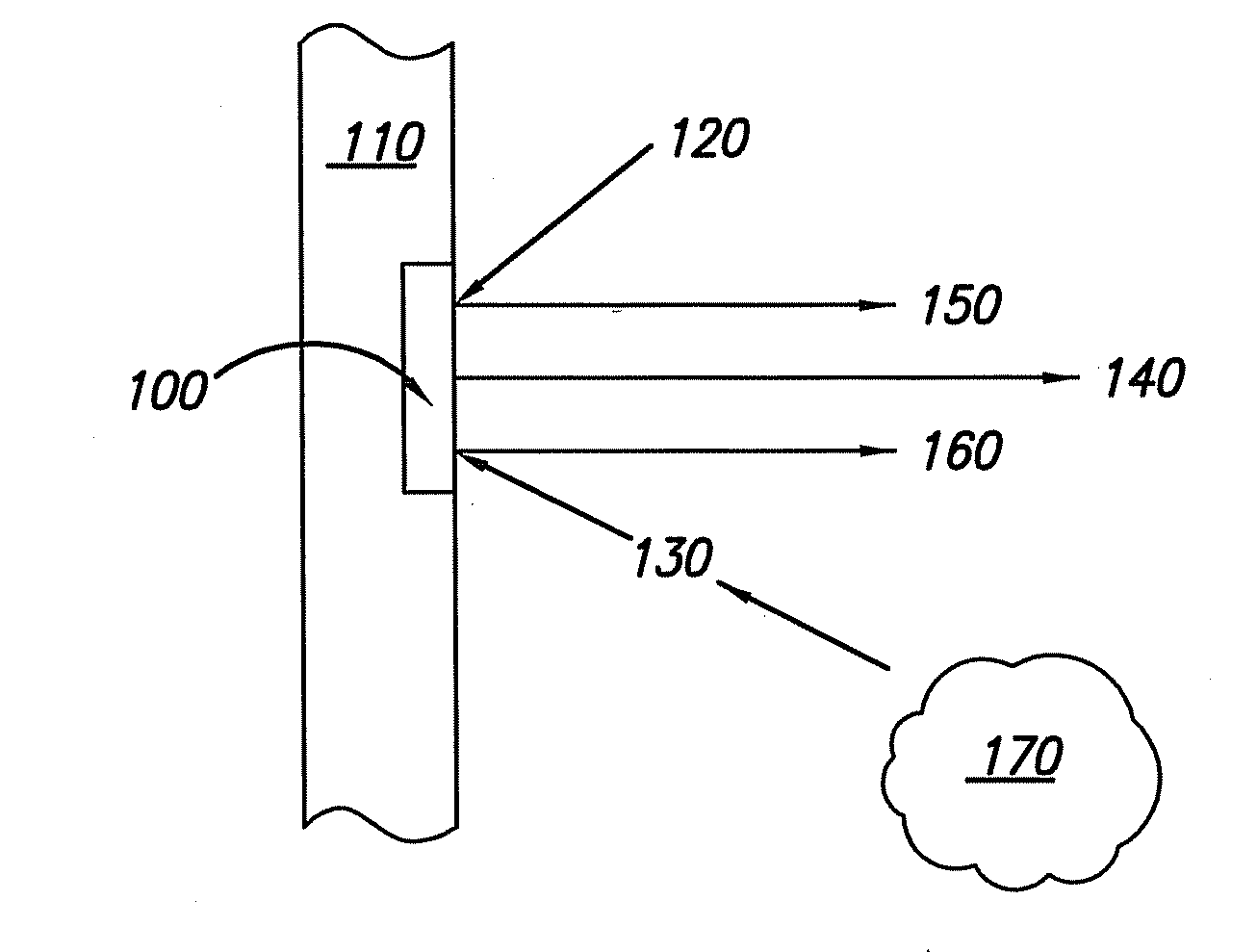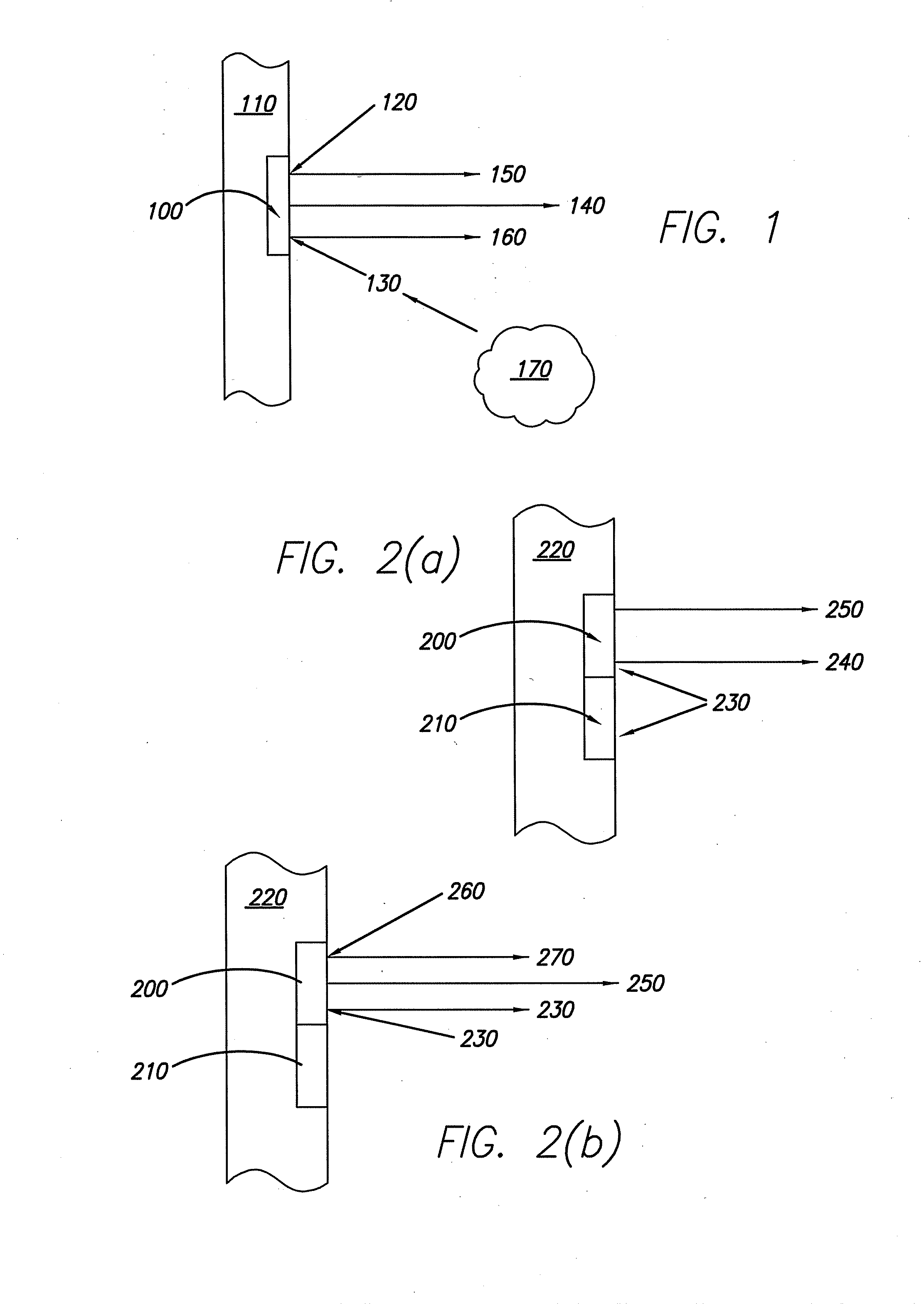Method of measuring in situ differential emissivity and temperature
a technology of differential emissivity and temperature measurement, applied in the field of methods, can solve problems such as failure of various components, further deterioration or spalling of coatings, and weakening of superalloy bodies
- Summary
- Abstract
- Description
- Claims
- Application Information
AI Technical Summary
Benefits of technology
Problems solved by technology
Method used
Image
Examples
example # 1
Example #1
[0045]One method of determining the differential emissivity between the first site and the second site is disclosed below. Each of the detection steps described in the specification will yield a total intensity of radiation at a first specified wavelength, ixy(λ1). The equation for the total intensity detected will have the following general form:
ixy(λ1)=[ambient radiation having wavelength λ1 that is reflected by site x]+[external radiation having wavelength λ1 that is reflected by site x]+[radiation emitted by site x having wavelength λ1]
The radiation detected from site X arising at a first wavelength, λ1, with and without radiation irradiated at λ1 are represented below:
iXE(λ1)=rx+ex+ix(εx, λ1, T) (with reflected external radiation)
ix0(λ1)=rx+0+ix(εx, λ1, T) (with no reflected external radiation)
where:[0046]rx=ambient radiation having wavelength λ1 that is reflected by site X;[0047]ex=external radiation irradiated having wavelength λ1 that is reflected by site X;[0048]i...
example # 2
Example #2
[0056]One method of determining the temperature of the first site and the second site is disclosed below. Taking each of the detection steps described in an embodiment for measuring temperature described above will yield a total intensity of radiation at a specified wavelength, ixy(λ1). In one method a total of six intensity measurements are taken using infrared radiation detection devices. For each site, the total intensity of radiation at a first wavelength will be detected with and without an external source of radiation, R(λ1). For each site, the total intensity of radiation at a second wavelength, λ2, will be detected without an external source of radiation. Using the labeling paradigm described in Example #1, the detected radiation arising from sites one and two can be represented as follows:
i1E(λ1)=r1+e1+i1(ε1, λ1, T) (17)
i10(λ1)=r1+0+i1(ε1, λ1, T) (18)
iE2(λ1)=r2+e2+i2(ε2, λ1, T) (19)
i20(λ1)=r2+0+i2(ε2, λ1, T) (20)
i10(λ2)=r1+0+i1(ε1, λ2, T) (21)
i20(λ2)=r2+...
example # 3
Example #3
[0064]Another method of determining the temperature of the first site and the second site is a slight modification of Example #2. As in Example #2, the method includes a total of six intensity measurements. For each site, the total intensity of radiation at a first wavelength may be detected with and without an external source of radiation, R(λ1). For each site, the total intensity of radiation at a second wavelength, λ2, will be detected with an external source of radiation, R(λ2). Using the labeling paradigm described in Example #1, the intensity of detected radiation arising from sites one and two can be represented as follows:
i1E(λ1)=r1+e1+i1(ε1, λ1, T) (33)
i10(λ1)=r1+0+i1(ε1, λ1, T) (34)
i2E(λ1)=r2+e2+i2(ε2, λ1, T) (35)
i20(λ1)=r2+0+i2(ε2, λ1, T) (36)
i1E(λ2)=r1+e1+i1(ε1, λ2, T) (37)
i2E(λ2)=r2+e2+i2(ε2, λ2, T) (38)
[0065]As shown in Example #1, equations (33) through (36) can be combined to yield equation (16):
Δɛ=Δi0′(λ1)-ΔiE(λ1)Eo
[0066]Sites one and two may b...
PUM
| Property | Measurement | Unit |
|---|---|---|
| temperature | aaaaa | aaaaa |
| temperature | aaaaa | aaaaa |
| emissivity | aaaaa | aaaaa |
Abstract
Description
Claims
Application Information
 Login to View More
Login to View More - R&D
- Intellectual Property
- Life Sciences
- Materials
- Tech Scout
- Unparalleled Data Quality
- Higher Quality Content
- 60% Fewer Hallucinations
Browse by: Latest US Patents, China's latest patents, Technical Efficacy Thesaurus, Application Domain, Technology Topic, Popular Technical Reports.
© 2025 PatSnap. All rights reserved.Legal|Privacy policy|Modern Slavery Act Transparency Statement|Sitemap|About US| Contact US: help@patsnap.com



